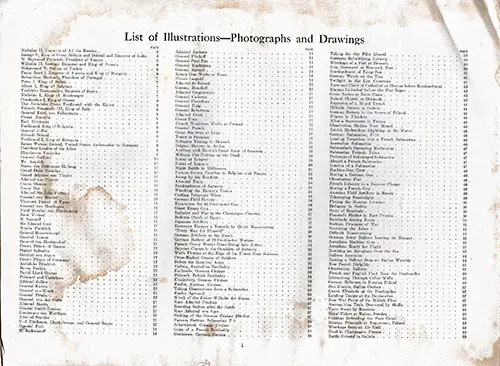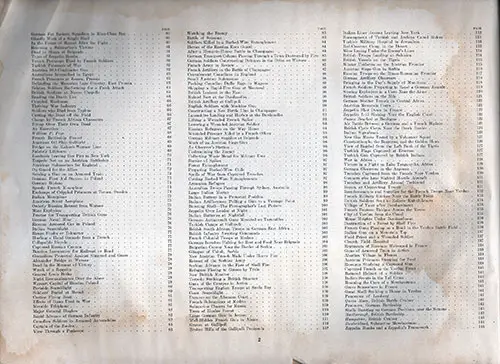Collier's Photographic History of the European War REDIRECTED
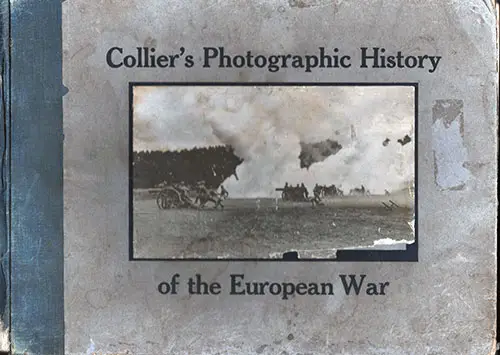
1916 Collier's Photographic History of the European War, by P.F. Collier & Son. Large, coffee-table format (16½" x 12") containing 144 pages. This spectacular account of the Great War includes sketches and drawings made on the battle fields and photographs by the official photographers accompanying each army.
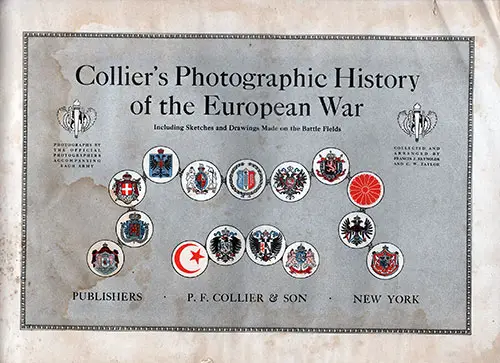
Summary
Pages 5 through 15 showcase the war's most important individuals. These include great leaders of many countries involved in the war: Czar of Russia Nicholas II; England's King George V; President Raymond Poincaré of France; German Emperor and King of Prussia Wilhelm II; Emperor of Austria and King of Hungary Franz Josef I, and many more.
These first pages also include several of the war's great military leaders: Supreme Commander of the French Army General Joffre; Commander in Chief of the British Home Fleet Admiral Jellico; German Field Marshal Von Hindenberg; Bavarian General Prince Leopold; and many more. The remainder of the book's pages contain some of the most compelling and riveting photographs of World War I to ever have been taken.
Throngs of villagers fleeing the horrors of war, pulling everything they own in horse-drawn carts through the streets; many young soldiers laying dead in the fields or trenches, their final supreme act of allegiance to their homeland forever preserved on film; the weaponry of various countries.
You will also find troop formations, units, and battalions from various countries in a variety of locations during the war; great ships such as the Sydney (Australian), the Emden (Germany), the Bulwark (England), and many, many more.
There is an incredible full-page photo of the great British Cunard liner Lusitania leaving New York (see photo below), which sunk after being torpedoed by a German submarine and took 1150 non-combatant lives (114 of them American), an act which outraged American citizens and eventually helped to draw the United States into the war.
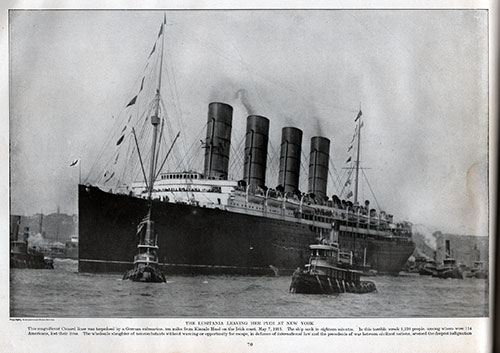
There are trench warfare photos; submarine photos; zeppelin and aeroplane photos; photos of the total destruction of once-thriving cities and towns caught in the path of war's relentless march; actual battle photos; photos of survivors of sunken ships, afloat in the sea just before rescue; a photo of the execution of accused spies; young foot soldiers who were killed as they became entangled in barbed wire and died standing upright, supported by the wire that had entrapped them; medics and nurses tending the wounded; photos from the battles at Gallipoli, Verdun, etc.; troops laying underground mines in tunnels beneath the enemy lines; Russian troops marching through wintry landscapes; etc.
Each photograph is a stark documentation of what war really means - graphic scenes which, these days, seem all too real.
Foreword to Collier's Photographic History of the European War
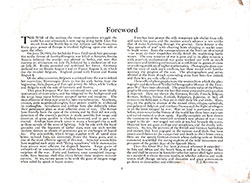
The War of the nations the most stupendous struggle the world has ever witnessed, is now raising along battle lines that stretch from the North Sea to the Adriatic and the Caucasus.
Every great power of Europe is involved fighting upon one side or upon the other.
On June 28.1914, the Archduke Franz Ferdinand, heir-presumptive to the throne of Austria-Hungary, was killed at Sarajevo. Bosnia. Austria believed the murder was plotted in Serbia, and sent that country an ultimatum on July 23, followed by a declaration of war on July 28.
Russia protested and mobilized her fonts. Germany declared war on Russia August 1 and on France August 3, on which day she invaded Belgium. England joined with France and Russia August 4.
Of the other countries, Belgium was forced into the war to defend her neutrality; Montenegro threw in her lot with Serbia from the beginning; Italy. Japan, and Portugal joined the Allies, while Turkey and Bulgaria look the side of Germany and Austria.
This great European War has introduced new and more deadly instruments of destruction, and has relegated to the background and the scrap heap many hitherto accepted tactics and weapons. The most effective of these new arms has been the submarine.
Gunboats, cruisers, even super dreadnoughts, have proven unable to withstand its onslaughts. Aeroplanes and airships have also definitely taken their permanent place as most effective arms of war.
The former have literally been the eyes of the armies, and by their aid not only detection of the enemy's position is made possible, but range and direction of great gunfire is checked, corrected, and in part conducted.
Airships have struck terror to many a besieged city as well as those outside of the zone of fighting. Side by side with the hand grenades and the bayonets of earlier days men use such terrible modern devices as clouds of poisonous gas or discharges of liquid fire.
The automobile, which brings supplies with all speed even when railroad lines are destroyed, draws the heavy guns and is one of the most effective agents of this war.
Armored automobiles have Supplied each army with "flying squadrons." white motorcycles have proven most efficient for dispatch hearers. Siege guns of unheard-of or unconceived-of caliber have been one of the great surprises of the war.
Forts and bastions once considered impregnable, have become shell-like china before these modern monster cannon. At sea, victory seems lo be with the guns of longest range when aided by speed or heavy armor.
Trenches have proven the only temporary safe shelter from rifle and quick fire guns, and the modern army's advance is not unlike that of moles burrowing through the ground.
Gone forever is the "gay panoply of war" with cheering hosts charging in scarlet coals to bugle notes. Even the correspondents at the front are eliminated—no more do their dispatches vividly detail the maddening battle scenes.
The very romance of war is gone and in its place remains a cold, practical, mathematical war game worked out with as much sentiment and bubbling enthusiasm as is exhibited in games of chess or in solving problems of higher mathematics.
Photographs alone now tell the story of each day's conflicts, but these record with fate-like accuracy the progress of the war. The photographers and artists allowed at the front of each contending army have been few indeed, and these few are only official ones.
These official photographers are the sources from which the photographs and sketches of "Collier's Photographic History of the European War" have been obtained. The great historic value of the Photographic history arises from the fact that every army and warring nation is depicted.
Here are shown the German, British, French, Italian, Russian. Serbian, Italian, Turkish, Bulgarian, Japanese, in fact, all armies in the field, seen as they are in their daily life and strife.
Here, too, are the pathetic dramas of the ruined cities villages, cathedrals, and palaces of Belgium and northern France, and the flight of refugees in all the lands ravaged by war.
War on land is portrayed as never before, since never in the history of the world has there been such vast and varied material to draw upon. Equally complete are here shown the instruments of the twentieth century's new- phases of war—war waged in the air—war waged not only at sea, but beneath the waves.
Depicted here are great airships and aeroplanes and the deadly submarines So, too, the pictures of the British and German battleships and cruisers that have engaged in the various naval duels that have meant annihilation to the vanquished and death to their brave crews.
Here are the speedy German cruisers whose dashing raids on British commerce resembled the daring exploits of the bold buccaneers and privateers of the golden days of the Spanish Main.
Thus this Great War has been pictured wherever it extended - in Asia and Africa and the South Seas, as well as in Europe. What the end shall lie cannot be foretold—whether nation shall light nation to a standstill without decisive results, or whether colonies and trade routes shall change owners and dynasties and great governments go down to destruction and oblivion.
F. J. Reynolds
List of Illustrations—Photographs and Drawings
- Nicholas II, Emperor of All the Russia
- George V, King of Great Britain, Ireland, and Emperor of India
- M. Raymond Poincaré, President of France
- Wilhelm II, German Emperor and King of Prussia
- Mohammed V, Saltan of Turkey
- Franz Josef I. Emperor of Austria and King of Hungary
- Bernardino Machado, President of Portugal
- Peter I. King of Serbia
- Albert I. King of Belgium
- Yoshthito Harunomiya. Emperor of Japan
- Nicholas 1, King of Montenegro
- Constantine I. King of Greece
- The Archduke Franz Ferdinand with the Kaiser
- Vittorio Emanuele III. King of Italy
- General Krieh von Falkenhayn
- Count Zeppelin
- Earl Kitchener
- Ferdinand, King of Bulgaria
- General Joffre
- Aristide Briand
- Ferdinand I, King of Romania
- James Watson Gerard, United States Ambassador to Germany
- Confident Leaders of the Allies
- Eleutherios Venizelos
- General Gallieni
- Mr. Asquith
- Baron von Bethmann-Hellweg
- Grand Duke Nicholas
- Grand Admiral von Tirpitz
- Admiral von Pliscott
- Count Okuma
- Enver Bey
- Admiral Sir John Fisher
- General von Beseler
- Viscount French of Ypres
- General von Heeringen
- Field Marshal von Hindenburg
- Rene Viviani
- M. Sazonoff
- Sir Edward Grey
- Nikola Paehitch
- General Rennenkampf
- General Leman
- General von Hoetzendorf
- Crown Prince of Greece
- Signor Salandra
- Gottlieb von Jafrow
- Crown Prince of Germany
- Archduke Friedrich
- Baron Burian
- David Lloyd George
- Poineare and Castelnau
- Admiral Jellico
- General Kamio
- General von Kluck
- General Petain
- General von der Goltz
- Admiral Beatty
- General Smith-Dorrien
- Lieutenant von Weddigen
- Admiral Sturdee
- Earl Kitchener, Lloyd-George, and General Roque
- General Foch
- M. Radoslavoff
- Admiral Jackson
- General Fitchoff
- General Paul Pau
- General Mackensen
- General Sarrail
- Krupp Gun Works at Essen
- Prince Leopold
- Admiral de Robeek
- General Brusiloff
- Admiral Gregorovich
- General Cadorna
- General Castelnau
- General Haig
- General Robertson
- Admiral Corsi
- Count Tisza
- French Munitions Works at Creusot
- General Putnik
- Great Stairway at Liege
- Tower at Spandau
- Refugees Fleeing to Brussels
- Belgian Battery in Action
- Artillery with Russia's Great Army of Invasion
- Military Car Picking up the Dead
- Ruins at Longwy
- Ruins of Louvain
- Night Battle in Miilhausen
- Picture Grown Familiar in Belgium and France
- Asleep by the Roadside
- Armored Train
- Bombardment of Antwerp
- Wrecking the Enemy's Trains
- Cutting Telegraph Wires
- German Field Battery
- Excavation for 42-Centimeter Gum
- Great Krupp Gun
- Industry and War in the Champagne Country
- Bedouin Chiefs of Egypt
- Japanese Artillery
- Destroyer Escapes a Torpedo by Quick Maneuvering
- "Every Man for Himself"
- German Artillery on the March
- German Battery of 21-Centimeter Mortars
- French Heavy Mortar Guns Going into Action
- Bayonet Charge in the Outskirts of Antwerp
- War's Victims at the Edge of the Forest Near Soissons
- Cross-Marked Graves of Soldiers
- Before the Invading Army
- Sydney, Australian Battleship
- Karlsruhe, German Cruiser
- Bulwark, British Battleship
- Konigsberg, German Cruiser
- Emden, German Cruiser
- Taking Observations from a Submarine
- Emden Aground
- Wreck of the Kaiser Wilhelm der Grosse
- Rear Admiral Cradock
- Rescuing Sailors after the Battle
- Rear Admiral von Spee
- Sinking of the German Cruiser Blücher
- Famous German Submarine U-9
- Scharnhorst. German Cruiser
- Guns of a French Battleship
- Gneisenau, German Cruiser
- Taking the Sky Pilot Aboard
- Germans Refortifying Antwerp
- Wreckage of a Fort at Brussels
- Gun Destroyed at Bismarck Fort
- Bombardment of Tsing-Tau
- German Watch on the Yser
- Twilight in the Low Countries
- Nave and Choir of Cathedral at Rheims before Bombardment
- Rheims Cathedral before the War Began
- Great Arches at Notre Dame
- Ruined Church at Dixmude
- Explosion of a Mined Trench
- Hillside Trench in Galicia
- German Battery in the Snows of Poland
- Winter in Flanders
- After a Snowstorm in France
- Observation Shelter Near Memel
- British Hydroplane Alighting on the Water
- German Submarine. U-14
- Loading Torpedoes into a French Submarine
- Australian Submarine
- Submarine's Operating Mechanism
- Submarine Torpedo Tubes
- Periscope of Submerged Submarine
- Aboard a French Submarine
- Interior of a Submarine
- Machine-Gun Crew
- Moving a German Gun
- Observation Post
- French Infantry in a Bayonet Charge
- Moving a French Gun
- Austrian Field Artillery in Russia
- Telescoping Searchlight
- Fleeing the Russian Invasion
- Refugees in Sorbin
- Story of Reprisals
- Peasant's Shelter in East Prussia
- Barricade Among Ruins
- Serbian Prisoners of War
- Searching the Ashes
- Difficult Home-coming
- German Army Balloon Leaving its Hangar
- Aeroplane Machine Gun
- Aeroplane Ready for Flight
- Rescuing an Aeroplane from the Sea
- Balloon Ascension
- Raising a Balloon from an Italian Warship
- New French Dirigible
- Observation Balloon
- French and English Fleet Near the Dardanelles
- In-trenching Through Cellar Walls
- German Riflemen in Russian Poland
- San Giorgio, Italian Cruiser
- Queen Elizabeth at the Dardanelles
- Landing Troops at the Dardanelles
- New War Paint of the British Fleet
- Ammunition Train Destroyed by Shells
- Town Swept by Russians
- Royal Palace at Malmo, Sweden
- Gurkhas Defending the Suez Canal
- Russian Prisoners at Angustowo, Poland
- Wreckage from an Air Raid
- Dead in Champagne, France
- Battle Ground in Galicia
- German Far Eastern Squadron in Kiau-Chau Bay
- Ghastly Work of a Single Shell
- In the Forest of Mesnel After the Fight
- Rescuing a Submarine's Victims
- Dead in Heaps at Belgrade
- Types of Zeppelin Bombs
- Trench Periscope Used by French Soldiers
- Turkish Prisoners of War
- Austrian 30.5-Centimeter Gun
- Australians Entrenched in Egypt
- French Prisoners at Zossen, Prussia
- Defending the Masurian Lake Country, East Prussia
- Belgian Soldiers Re-Forming for a Fresh Attack
- British Soldiers at Neuve Chapelle
- Reading the Death List
- Crippled Workman
- Thriving War Industry
- Soldiers who Died from Typhus
- Carting the Dead off the Field
- Charge by French African Chasseurs
- Firing Over Their Own Dead
- An Execution
- William P. Frye
- French Battleship Bouvet
- American Oil Ship Gulfight
- Bridge On the Kalesch-Warsaw Line
- Falaha's Lifeboats
- Lusitania Leaving Her Pier in New York
- Torpedo Net on an Austrian Battleship
- American Submarines for England
- On Guard for the Allies
- Serving a Gun on an Armored Train
- German First Aid Station in Poland
- German Biplane
- Speedy French Monoplane
- Exchange of Crippled Prisoners at Tornea, Sweden
- Italian Monoplane
- American Scout Aeroplane
- Orderly Russian Retreat from Warsaw
- Mine Explosion
- Tractor for Transporting British Guns
- German Naval Mine
- Russian Armored Car in Poland
- Italian Searchlight
- Range Finder or Telemeter
- Hurling a Hand Grenade from a Trench
- Collapsible Bicycle
- Captured Russian Cannon
- Benzine Locomotive for Railroad or Road
- Grenadiers Protected Against Shrapnel and Gases
- Alexander Bridye at Warsaw
- Dead in the Moment of Victory
- Wreck of a Zeppelin
- General Louis Botha
- Night Reconnaissance Over the Aisne
- Warsaw, Capital of Russian Poland
- Portable Searchlight
- Soldiers' Burial at Meniel
- Curtiss Flying Boat
- Effects of Gases Used in War
- Movable Telephone
- Major General Hughes
- Rapid Advance of German Infantry
- Canadian Soldiers in Armored Automobiles
- Captain of the Emden
- View Through a Periscope
- Watching the Enemy
- Battle of Soissons
- Soldiers Killed in a Barbed-Wire Entanglement
- Heroes of the Russian Rear Guard
- After a House-to-House Battle in Champagne
- German Transport Column Passing Through a Town Destroyed by Fire
- German Soldiers Constructing Defenses in the Drive on Warsaw
- French Army in Review
- French Artillery in the Battle of Champagne
- Convalescent Canadians in England
- Small Austrian Submarine
- Packing Canadian Duffle Rags in Wagons
- Shipping a Rapid-Fire Gun at Montreal
- British Lookout in the East
- Ruined Fort at the Dardanelles
- British Artillery at Gallipoli
- English Soldiers with Machine Gun
- Constructing a New Battle Line in Champagne
- Lancashire Landing and Harbor at the Dardanelles
- Lifting a Wounded French Sailor
- Lowering: a Wounded Austrian Soldier
- Russian Refugees on the Way Home
- Wounded Prisoner Aided by a French Officer
- German Military Supplies at Belgrade
- Work of an Austrian Siege Gun
- An Observer's Station
- Undermining the Enemy
- Collecting Waste Metal for Military Uses
- Barrier of Spikes
- Forest Entanglement
- Preparing Barbed-Wire Coils
- Spoils of War from Captured Trenches
- Cutting Barbed-Wire Entanglements
- Armenian Refugees
- Australian Troops Passing Through Sydney, Australia
- Large Italian Mortar
- Italian Battery in a Protected Position
- Italian Artillerymen Pulling a Gun to a Vantage Point
- Bursting Shell—The Photographer's Last Picture
- Zeppelin Over London at Night
- Italian Batteries at Nightfall
- German Antiaircraft Guns Mounted on Turntables
- Turkish Camps at Gollipoli
- British South African Troops in German East Africa
- British Infantry Awaiting Commands
- French Colonial Troops at Mudros
- German Invaders Halting for Rest and Food Near Belgrade
- Bulgarian Convoy Near the Border of Serbia
- Glimpse of Uskub, Serbia
- New Austrian Trench Made Under Heavy Fire
- Retreat of the Serbian Army
- Serbian Advance in the Face of Shell Fire
- Refugees Fleeing to Greece by Train
- New British Monitor
- Torpedo Striking a British Steamer
- Guns of the Canopus in Action
- Transporting English Troops at Suvla Bay
- Coast Searchlight
- Duraxzo on the Albanian Coast
- French Submarines at Mudros
- Submarine Chasers for Russia
- Trees of Hurlus Forest
- Large German Gun in Action
- Well-Hidden French Gun in Alsace
- Graves at Gallipoli
- Broken Hills of the Gallipoli Peninsula
- Italian Liner Ancona Leaving New York
- Encampment of Turkish and Arabian Camel Riders
- Turkish Military Hospital in Jerusalem
- Red-Crescent Camp in the Desert
- Mine Laying Under the Enemy's Lines
- British Troops Landing at Saloniea
- British Vessels on the Tigris
- Winter Uniforms on the Austrian Frontier
- Austrian Siege Gun in Serbia
- Russian Troops on the Russo-Romanian Frontier
- German Artillery Observers
- Bringing in the Day's Supply of Munitions
- French Soldiers Preparing to Repel a German Assault
- Storing Explosives in a Cave Near the Aisne
- British Soldiers on the Nile
- German Shelter Trench in Central Africa
- Austrian Mountain Corps
- Zeppelin Shot Down in France
- Zeppelin L-15 Sinking Near the English Coast
- Sussex Beached at Boulogne-sur-Mer
- Air Battle Between a German and a French Biplane
- British Cycle Corps Near the Greek Border
- Italian Signalman
- New Gas Masks Tested by a Volunteer Squad
- Constantinople, the Bosporus, and the Golden Horn
- View of Baghdad from the Left Bank of the Tigris
- Turkish Flags Captured at Erzerum
- Turkish Gun Captured by British Indians
- War in Africa
- Victors in a Fight on Lake Tanganyika. Africa
- German Observers in the Argonne
- Trenches Captured from the French Near Verdun
- Gunners who have Sighted Hostile Aircraft
- Trenches and Artillery Around Trehizond
- Boyau, or Connecting Trench
- Reinforcements and Supplies for the French Troops Near Verdun
- French Military Kitchen Near the Battle Front
- British Soldiers Sent to Relieve Kut-el-Amara
- Village of Vaux after Bombardment
- French Pontoon Bridges Across the Mouse
- City of Verdun from the Canal
- Mouse Heights Under Bombardment
- Destruction of a Forest by Shell Fire
- French Guns Passing on a Road in the Verdun Battle Field
- Italian Gun on a Mountain Top
- Field Priest and a Wounded Soldier
- Church Field Hospital
- Regiments of Russians Welcomed in France
- Guns of Armored Train in Action
- Alsatian Village in Flames
- Austrian Prisoners Stopping for Food
- Russians Studying a Captured Gun
- Captured Trench on the Verdun Front
- Italian Scouts in the Tall Grass
- Rescuing the Crew of a Merchantman
- Grave Somewhere in France
- Great Shell Striking a House in Verdun
- Panorama of Lemberg
- Queen Mary, British Battle Cruiser
- Pommern, German Battleship
- Shells Bursting on German Positions near the Somme
- Marlborough, British Battleship
- Hampshire, British Cruiser
- Deutschland, Submarine Merchantman
- Zeppelin Bombs and a Zeppelin's Framework
